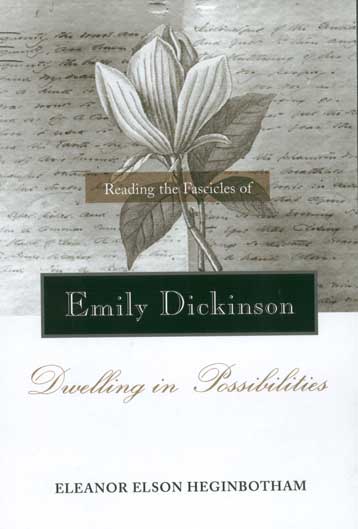
Reading the Fascicles of Emily Dickinson
Dwelling in Possibilities
Eleanor Elson Heginbotham
“The strength of this study lies in Heginbotham’s demonstration that reading poems in fascicle contexts encourages interpretations that are either not apparent or not as vivid when the poems are read in isolation. . . . Heginbotham's study makes an important contribution to Dickinson scholarship by modeling fascicle reading that effectively communicates not only the interpretive insights enabled by the fascicles, but also the pleasures that attend reading Dickinson's poems in the setting Dickinson selected. Heginbotham's delight is evident on every page . . . .” —Legacy
 “[F]ascinating and most compelling to read . . . . offers all readers of Dickinson an important
new way to understand the enigmatically dazzling work of this complex American
poet”— Books in Canada
“[F]ascinating and most compelling to read . . . . offers all readers of Dickinson an important
new way to understand the enigmatically dazzling work of this complex American
poet”— Books in Canada
“Heginbotham argues that the fascicles provide the best context for reading Dickinson and gives a very full demonstration of how selected fascicles can be read. The breadth of her knowledge, as well as the fairness and accuracy of her use of other critics, is exceptional. Reading the Fascicles of Emily Dickinson is both persuasive and graceful.” —John Gerlach, Cleveland State University
Heginbotham’s book focuses on Emily Dickinson’s work as a deliberate writer and editor. The fascicles were forty small portfolios of her poems written between 1856 and 1864, composed on four to seven stationery sheets, folded, stacked, and sewn together with twine. What revelations might come from reading her poems in her own context? Are they simply “scrapbooks,” as some claim, or are they evidence of conscious, canny editing? Read in their original places, each lyric becomes different—and usually more interesting—than when read in isolation.
We cannot know why Dickinson compiled the books or what she thought of them, but we can observe what she left in them. What she left is visible only by noting the way the poem answers in a dialogue across the pages, the way lines spilling onto a second page introduce the next poem, the way openings suggest image clusters so that each book has its own network of concerns and language—not a story or philosophical preachment but an aesthetic wholeness.
This book is the first to demonstrate that Dickinson’s poetic and philosophical creativity is most startling when the reader observes the individual lyric in the poet’s own, and only, context for them. For teacher, student, scholar, and poetry lover, Heginbotham creates an important new framework for an understanding one of the most complex, clever, and profound U.S. poets.
Eleanor Elson Heginbotham is professor of English at Concordia University
of St. Paul.
| Jun
2003
19th-century literature 300 pp. 6x9 5 illus. |
|
| $29.95 paperback 978-0-8142-5569-8 | Add paperback to shopping cart |
| $74.95 cloth 978-0-8142-0922-6 | Add cloth to shopping cart |
| $14.95 CD 978-0-8142-9004-0 | |


